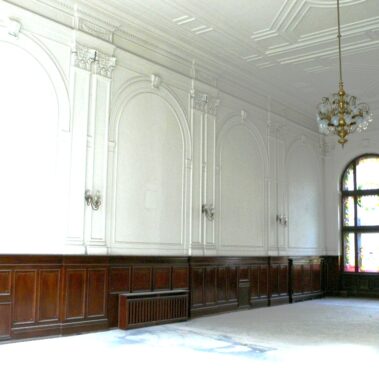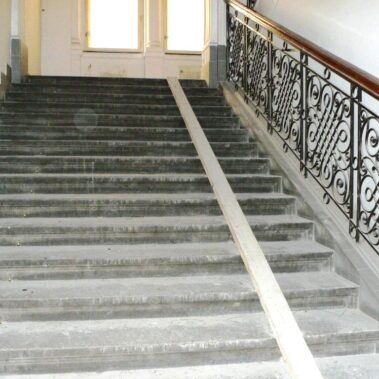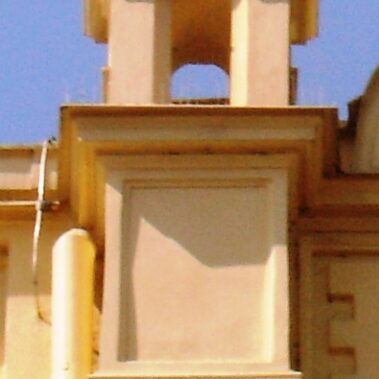Hotel Kings Court - house conversion into a hotel, Prague, Czech Republic

| Address: | Hotel Kings Court, U Obecního domu 660/3, Praha |
|---|---|
| Description of work: | Reconstruction of the façade including stucco and decorative elements
Repairs to the roof Blacksmith and carpentry work Building work Renovation of the stained glass windows |
| Contractor: | GEMA ART GROUP a.s. |
| Investor: | GEO – ING Jihlava spol. s.r.o. |
| Implementation: | 08/2007 – 12/2009 |
The location of what is today Kings Court Hotel has a rich history. Past archaeological surveys had established that the area had been settled since the 12th century with local craftsmen and traders, who built Romanesque town houses here.
The area particularly flourished during the reign of the King Wenceslas IV (1378 – 1419). The king did not spend a great deal of time at Prague Castle and commissioned, as a modern alternative to it, a grandiose Royal Palace at the site of today’s Municipal House and Kings Court Hotel. The palace was also favoured as a sovereign’s residence by later rulers Sigismund of Luxemburg and Jiří of Poděbrady. It was not until the Jagiellon dynasty came to power that Prague Castle regained its status as the centre of royal power. The Royal Palace gradually fell into disrepair and was in the 16th century sold off to a member of the nobility. During the 18th and 19th centuries the complex was used as a barracks and a military academy.
The complex was sold to the commercial bank Živnostenská banka in 1900, who decided to demolish it and build on the site a new Palace of the Chamber of Trade and Commerce. The project was the work of the architect Antonín Turek, who also designed Vinohrady theatre. The Neo-Renaissance building with elements of Art Nouveau style was erected between the years 1903 and 1905. In 1922 some alterations were carried out according to design by the architect Matěj Blecha and in 1956 a sixth floor level was added.
The conversion of the building into a hotel undertaken from 2007 to 2009 was the most extensive reconstruction in its architectural history and it was carried out with a particular regard to the original division of the structure into individual entities. Thus Hotel Kings Courts, together with the adjacent Municipal House and Hotel Paříž, constitutes a unique example of the architecture from the turn of the 19th and 20th century.
The complete reconstruction of the Neo-Renaissance building in the centre of Prague was divided into several stages and took place from 2007 till 2009. The company GEMA ART GROUP a. s. was the main subcontractor for the provision of restoration, craft and artisan as well as building work, which was carried out from August 2007 until December 2009 both on the exterior and the interior of the building. GEMA ART GROUP a.s. was responsible for the expert reconstruction of the façade. The selected colour was based on the 2008 research into the original colour scheme. Partial renovation of the façade had already been undertaken in 2006. As part of the extensive work on the exterior the copper roof was reconstructed, including the sheathing of the ornamental chimneys, roof turrets and scrolls. The interior work involved carpentry tasks, expert dismantling of the tile flooring and restoration of the stained glass windows. All work was carried out according to the required technical parameters and by expert restorers licensed by the Ministry of Culture of the Czech Republic.
Reconstruction of the facade:
Before the complex restoration of the hotel’s façade could commence it was necessary to carry out a survey of the original colouring of the plasters and establish the level of dampness and resulting salinity of the masonry. As the result of probing it was found that the original façade was coated in an ochre to beige colour. According to the stipulation of the Heritage Institute, this colouring was to be recreated.
The existing dampness was treated with a chemical insulation compound, which was injected into the masonry. The layers of non-original paint were removed mechanically using stripping knives. The surface was cleaned by steam jet. The façade was then coated with restoration plaster and its lower parts were given an anti-graffiti layer. The stone wall base was also repaired during the restoration.
Sculptural elements of the facade:
The exterior of the hotel is ornamented with many decorative stone elements, such as shallow block stone sculptural bosages, ledges and inscriptive stone tablets in the shape of simple cartouches. The bay windows are decorated with stucco mouldings and there are baluster railings. The ledge of the attic has decorative pagodas and the gables are ornamented with stone urns. These urns and pagodas were the most exposed to the elements and as a result most damaged. Some of the balusters had to be completely replaced as their metal reinforcements had corroded away. The dirt on the surface of the stone elements was removed and missing parts were replaced by exact copies cast in Lukopren moulds. The new casts were given non-corrosive reinforcements. In cases of partial damage the missing parts were remodelled and injected with a strengthening compound.To conclude the work, colour retouching and hydrophobic treatment were carried out.
Repair of the roof:
Before the reconstruction could commence the unsuitable roof covering of asbestos cement flat panels had to be removed. GEMA ART GROUP a.s. was also responsible for the repairs and replacement of the pan tiles and for copper sheathing. The copper sheathing of the turrets was also coated with sodium polysulphide. The tin roofing on the courtyard side was covered with zinc titanium.
Blacksmith work:
GEMA ART GROUP a.s. was also involved in the minor blacksmithing and metal fitting tasks involving the manufacture of replicas of the grilles, flagpoles and railings on the roof and the staircases. Metal parts exposed to the elements were coated in zinc.
Carpentry work:
Carpentry work concerned the dismantling and refitting of the windows. Restoration and specialist craft work was also carried out on the interior wood panelling, doors and wooden parts of the staircase.
Building work:
The company was responsible for a portion of the building work, such as demolition tasks and construction of new openings.
Dům byl přestavěn na luxusní pětihvězdičkový hotel. Více informací naleznete ZDE.































